Showing Spotlights 105 - 112 of 556 in category All (newest first):
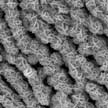 Researchers have successfully produced durable antiviral surfaces that inactivate SARS-CoV-2 within 6 hours. In contrast, on various non-nanostructured surfaces or smooth surfaces, the SARS-COV-2 virus remained viable for up to 48 hours. These results provide evidence that surfaces that are structured with specific nanoscale surface features are effective in preventing SARS-CoV-2 and the subsequent environmental spread. Such nanostructured surfaces can be used in hospital environments and can be extended to other industrial sectors and public infrastructure such as transportation, where fomites or contaminated surfaces are carriers for viral infections.
Researchers have successfully produced durable antiviral surfaces that inactivate SARS-CoV-2 within 6 hours. In contrast, on various non-nanostructured surfaces or smooth surfaces, the SARS-COV-2 virus remained viable for up to 48 hours. These results provide evidence that surfaces that are structured with specific nanoscale surface features are effective in preventing SARS-CoV-2 and the subsequent environmental spread. Such nanostructured surfaces can be used in hospital environments and can be extended to other industrial sectors and public infrastructure such as transportation, where fomites or contaminated surfaces are carriers for viral infections.
Sep 18th, 2020
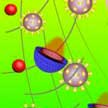 Biofilm formation is an important adaptation and survival strategy commonly employed by bacteria but, unfortunately, a major cause for infections in humans. Researchers have now demonstrated the safe removal of in vivo bacterial biofilms through artificial nanomotors driven by near-infrared laser light. This is the first demonstration of a self-propelled antibiofilm platform capable of conducting photothermal and antibiotic therapy in the deep layers of biofilm, achieving high therapeutic efficiency in vivo without damaging healthy tissues.
Biofilm formation is an important adaptation and survival strategy commonly employed by bacteria but, unfortunately, a major cause for infections in humans. Researchers have now demonstrated the safe removal of in vivo bacterial biofilms through artificial nanomotors driven by near-infrared laser light. This is the first demonstration of a self-propelled antibiofilm platform capable of conducting photothermal and antibiotic therapy in the deep layers of biofilm, achieving high therapeutic efficiency in vivo without damaging healthy tissues.
Sep 8th, 2020
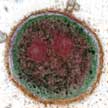 The physicochemical properties of nanoparticles alone cannot predict the fate of nanoparticles in biological systems. Current evidence suggests that the formation of a corona on the nanoparticle surface is the most important parameter that controls nanoparticle toxicity. Scientists now showed that protein corona modulates internalisation and cytotoxicity of nanodiamonds in non-phagocytic and phagocytic cells. Specifically, they found that corona made of bovine serum albumin (BSA), which represents the most abundant protein in blood plasma, reduced nanodiamond agglomeration.
The physicochemical properties of nanoparticles alone cannot predict the fate of nanoparticles in biological systems. Current evidence suggests that the formation of a corona on the nanoparticle surface is the most important parameter that controls nanoparticle toxicity. Scientists now showed that protein corona modulates internalisation and cytotoxicity of nanodiamonds in non-phagocytic and phagocytic cells. Specifically, they found that corona made of bovine serum albumin (BSA), which represents the most abundant protein in blood plasma, reduced nanodiamond agglomeration.
Sep 4th, 2020
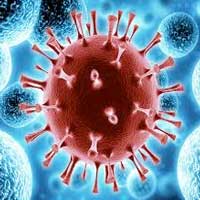 The only options to control and deal with the spread of the Severe Acute Respiratory Syndrome Virus 2 (SARS-CoV-2) are fast, cheap, reliable, and portable means of diagnosing COVID-19 infection (the name of disease caused by SARS-CoV-2); therapeutics to treat the infected; and vaccines to rapidly build up immunization of large parts of the global population. The current crisis demands an urgent analysis of all the available nanotechnology tools. While nanomedicine strategies are in use for the design of the vaccine carriers, there are not enough other nanotechnology approaches being explored to tackle the current outbreak.
The only options to control and deal with the spread of the Severe Acute Respiratory Syndrome Virus 2 (SARS-CoV-2) are fast, cheap, reliable, and portable means of diagnosing COVID-19 infection (the name of disease caused by SARS-CoV-2); therapeutics to treat the infected; and vaccines to rapidly build up immunization of large parts of the global population. The current crisis demands an urgent analysis of all the available nanotechnology tools. While nanomedicine strategies are in use for the design of the vaccine carriers, there are not enough other nanotechnology approaches being explored to tackle the current outbreak.
Jun 26th, 2020
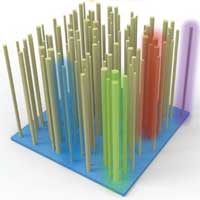 Vertical semiconductor nanowire arrays are a promising material for retinal prostheses, which could help restore the eyesight of people suffering from severe retinal diseases. These nanowires could also be used to fabricate bio-inspired photoreceptors and lightweight, highly efficient photovoltaics. In new work, scientists present theoretical and experimental studies on the microscopic optical behavior of highly dense and randomly distributed nanowire arrays embedded in a transparent polymer.
Vertical semiconductor nanowire arrays are a promising material for retinal prostheses, which could help restore the eyesight of people suffering from severe retinal diseases. These nanowires could also be used to fabricate bio-inspired photoreceptors and lightweight, highly efficient photovoltaics. In new work, scientists present theoretical and experimental studies on the microscopic optical behavior of highly dense and randomly distributed nanowire arrays embedded in a transparent polymer.
Jun 18th, 2020
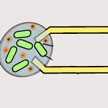 New research demonstrates the integration of synthetic biology with electronic circuitry through engineered population dynamics that regulate the accumulation of charged metabolites. The resulting sensor devices can detect changes in bacterial population in response to the presence of chemicals, light or pH. Connecting bacterial gene expression to electrodes is an appealing approach to interface genetic circuits with microelectronics for multiple applications. In this work, researchers engineered bacterial circuits capable of controlling the conductivity of the media via cell growth and death. Therefore, the electronic output is controlled by a killing gene.
New research demonstrates the integration of synthetic biology with electronic circuitry through engineered population dynamics that regulate the accumulation of charged metabolites. The resulting sensor devices can detect changes in bacterial population in response to the presence of chemicals, light or pH. Connecting bacterial gene expression to electrodes is an appealing approach to interface genetic circuits with microelectronics for multiple applications. In this work, researchers engineered bacterial circuits capable of controlling the conductivity of the media via cell growth and death. Therefore, the electronic output is controlled by a killing gene.
May 26th, 2020
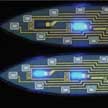 Miniaturized needle-like carriers in high aspect ratio structures are a novel class of implantable electronic devices. They are used to deliver tiny sensors and stimulation tools inside the body via minimally invasive injection or insertion into a specific area of an organ. A recent review summarizes the latest developments in materials, designs, and manufacturing techniques in the field of injectable biomedical devices, highlighting unique applications and demonstrations of viable clinical tools that were applied in various internal organs.
Miniaturized needle-like carriers in high aspect ratio structures are a novel class of implantable electronic devices. They are used to deliver tiny sensors and stimulation tools inside the body via minimally invasive injection or insertion into a specific area of an organ. A recent review summarizes the latest developments in materials, designs, and manufacturing techniques in the field of injectable biomedical devices, highlighting unique applications and demonstrations of viable clinical tools that were applied in various internal organs.
May 19th, 2020
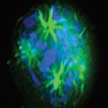 Hepatocellular carcinoma (HCC) is is the most common type of primary liver cancer and one of the most aggressive and hyper-vascularized forms of cancer. Many current chemotherapeutics fail to achieve the effective therapeutic index in the solid tumours due to poor drug penetration, poor bioavailability, non-specificity and drug resistance - a challenging aspect in this field. In search of new modalities, researchers have developed multifunctional polymeric nanoparticles against HCC. These biocompatible multifunctional polymeric nanoparticles hold trimodal affinity towards targeting microtubules, tyrosine kinases, and high-sensitivity imaging system quantum dots.
Hepatocellular carcinoma (HCC) is is the most common type of primary liver cancer and one of the most aggressive and hyper-vascularized forms of cancer. Many current chemotherapeutics fail to achieve the effective therapeutic index in the solid tumours due to poor drug penetration, poor bioavailability, non-specificity and drug resistance - a challenging aspect in this field. In search of new modalities, researchers have developed multifunctional polymeric nanoparticles against HCC. These biocompatible multifunctional polymeric nanoparticles hold trimodal affinity towards targeting microtubules, tyrosine kinases, and high-sensitivity imaging system quantum dots.
May 14th, 2020
 Researchers have successfully produced durable antiviral surfaces that inactivate SARS-CoV-2 within 6 hours. In contrast, on various non-nanostructured surfaces or smooth surfaces, the SARS-COV-2 virus remained viable for up to 48 hours. These results provide evidence that surfaces that are structured with specific nanoscale surface features are effective in preventing SARS-CoV-2 and the subsequent environmental spread. Such nanostructured surfaces can be used in hospital environments and can be extended to other industrial sectors and public infrastructure such as transportation, where fomites or contaminated surfaces are carriers for viral infections.
Researchers have successfully produced durable antiviral surfaces that inactivate SARS-CoV-2 within 6 hours. In contrast, on various non-nanostructured surfaces or smooth surfaces, the SARS-COV-2 virus remained viable for up to 48 hours. These results provide evidence that surfaces that are structured with specific nanoscale surface features are effective in preventing SARS-CoV-2 and the subsequent environmental spread. Such nanostructured surfaces can be used in hospital environments and can be extended to other industrial sectors and public infrastructure such as transportation, where fomites or contaminated surfaces are carriers for viral infections.
 Subscribe to our Nanotechnology Spotlight feed
Subscribe to our Nanotechnology Spotlight feed





